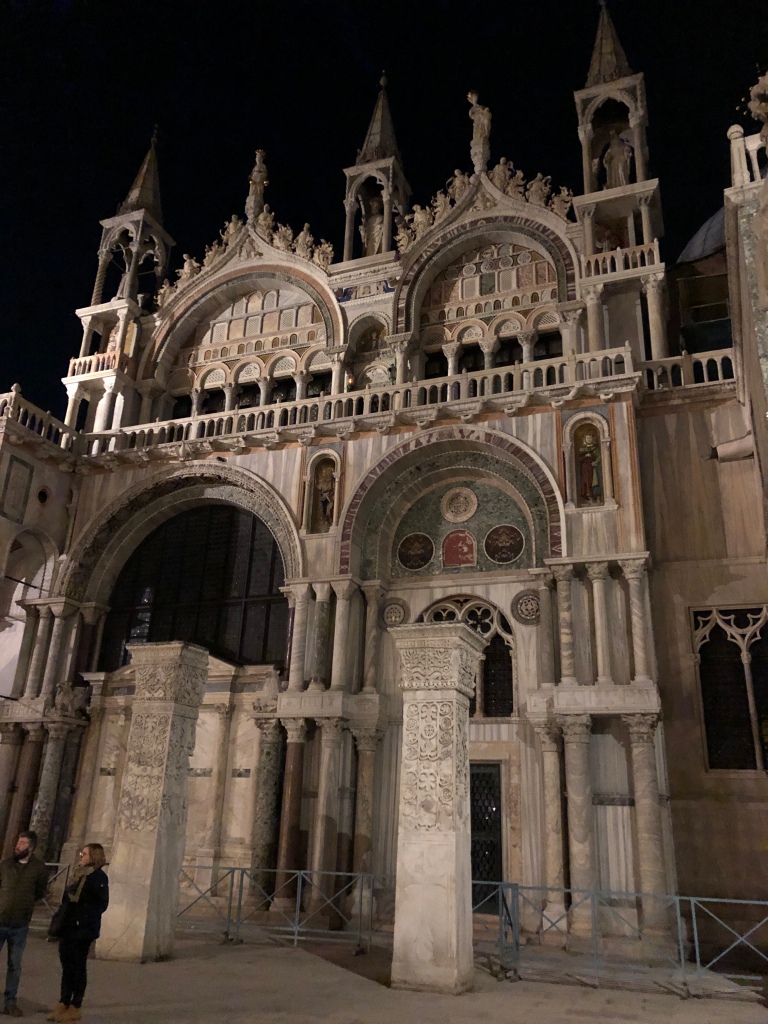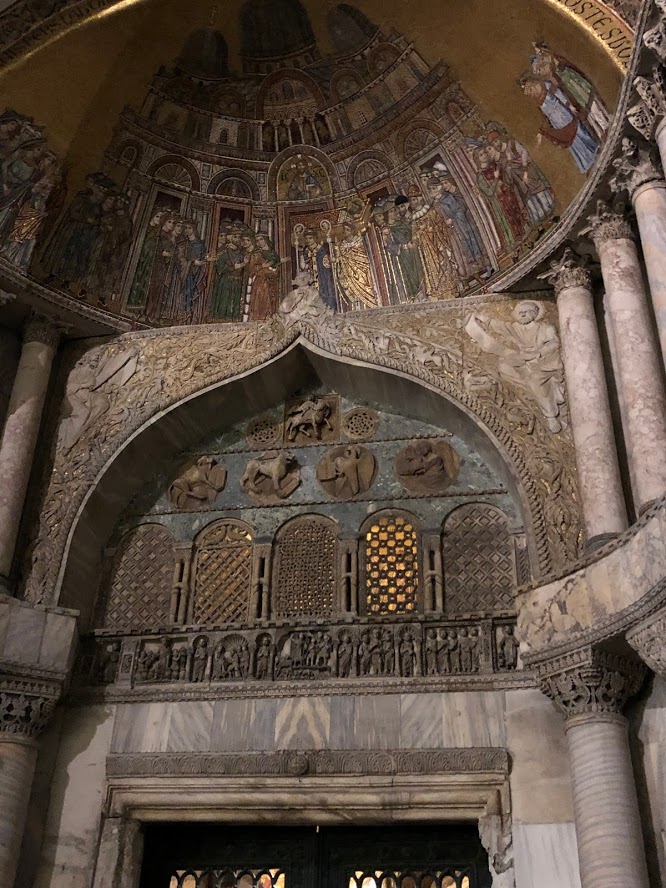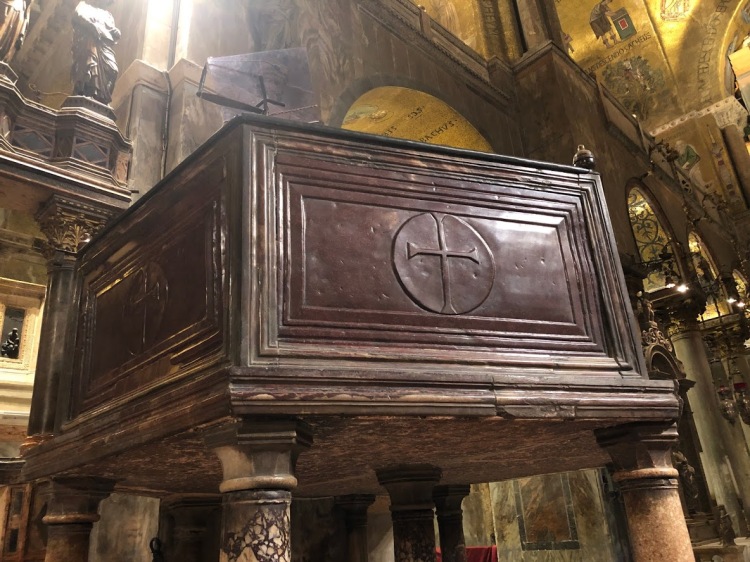I have just experienced an ‘out of hours’ private visit to St Mark’s Basilica, Venice – it was just fabulous. This grand, eastern style, church was built to house the relics (bones) of St Mark – one of the four evangelists or gospel writers. The church in its current form dates from the late 11th, early 12th century. It has been expanded, rebuilt, altered and remodelled on numerous occasions ever since.
LEGEND has it that two brave and hearty Venetians stole the body of St Mark from Alexandria in Egypt and brought it back to Venice. This was in the 9th century after Christ. A mosaic in one of the niches outside the church, shows Mark’s body being hidden in a basket of pork (to prevent Muslim officials from searching the contents). The basket was then transported back to Venice where a suitable majestic resting place had to be created. Originally the patron saint of Venice was St George, however as Venice’s power and prestige increased the city fathers felt a more important and higher ranking patron saint was required. Mark, as one of the gospel writers and an evangelist, was a perfect choice. For many years the church of St Mark’s was the private chapel of the ‘Doge’ the ducal head of the Republic of Venice. There was a side entrance leading directly from the Palazzo Ducale into the church. Today the main entrance into the basilica is from St Mark’s Square. As I entered the atrium of the church and gazed around me I was overwhelmed by the richness of the interior. Every available surface is covered with elaborate decorations and mosaic ceilings, often in gold. The floors are mosaics too in both Roman and Byzantine styles. Floors, walls and ceilings are richly adorned with intricate patterns.


THE ATRIUM or external covered arcade of the church is richly decorated with old testament mosaics. It is possible to identify the story of Adam and Eve, their time in the Garden of Eden and the temptation they encountered there. There’s also a mosaic of the construction of the Tower of Babel surrounded by crowds of people – presumably speaking in numerous tongues. Next I spot a big boat and pairs of animals waiting to get on board – that must be a representation of Noah’s Ark. Mosaics cover every inch of surface area on the walls and domes that surround me. In fact a beady eyed visitor can even spot Adam and Eve having a bit of a kiss and a cuddle – unique in religious imagery, according to our charming guide Natalia. I’m not surprised, the Venetians are a canny, wily bunch and they’ve always enjoyed a little bit of irreverence when it comes to religion.


As our little party climbs half a dozen steps to enter the main body of the basilica I have a feeling that I am entering into a mosque or an eastern place of worship. The feeling is definitely oriental. In fact my feeling of entering into a Byzantian atmosphere is quite correct, various treasures looted from Constantinople, at the time of the Fourth Crusade were brought back to Venice, by the Venetians for safe-keeping. Some might call it looting, the Venetians regarded it as stewardship of important artistic heritage. This central core of the church was built about one thousand years ago. So it’s no great surprise that subsidence, wear and tear and endless visitors have left their mark on this unique historic place. The floors are irregular and undulating, like waves on a beach.
THE PULPIT – where the bishops and clergy gave the faithful a good lecture every Sunday, is the biggest piece of porphyry (royal, purple stone) I have ever seen. Quite spectacular. It was almost certainly pillaged from the Church of Hagia Sofia, in Constantinople, when Christian forces ransacked the city and stole many of its treasures, in 1204. The pulpit is so vast that 8 pillars are required to support it. Each one is shaped from different coloured stone. In fact the pulpit and its monumental dimensions sums up the egotistical and self-righteous attitude that the Venetians had to their territories and their wealth in the 13th and 14th centuries.
DECORATION – Further into the church we admire the complicated array of domes above our heads, all decorated with golden mosaics, depicting the New Testament and the life of Christ. Jesus entering Jerusalem on a donkey is beautifully portrayed. So too are the saints, apostles and angels. They are all represented in the earthly paradise that is the Basilica of St Mark’s. Behind the High Altar there is a magnificent screen embossed with gold, enamel and hundreds of precious stones. This screen is known as the Pala d’Oro it gleams and sparkles as the emeralds, sapphires, rubies and enamel pieces reflect the light. Usually it faces the back wall of the church. It is rotated to face the congregation and for all to admire, only on important feast days. It is regarded as possibly the finest example of Byzantine design and artistry, and dates from the 10th century. It is yet another reminder of Venice’s intimate connection with the eastern Mediterranean and the lucrative trade routes it once controlled.

St Mark’s Basilica 
Venice – mosaic floor detail with peacock – pavone mosaic 
Venice – San Marco – exterior mosaics 
Porta della Carta – winged lion of St Mark dominates this huge, timber door 
Venice – San Marco – alabaster carving – detail of pillar
DESCENDING INTO THE CRYPT – next we made our way down some worn quartzite steps into the very bowels of the church. Here we found ourselves beneath everything; church, domes, mosaics, floors, ceilings, lead-covered roof tops, all piled above our heads, tons and tons of material. Below us the consolidated mud, timber and detritus of the lagoon, deposited and carbonised over thousands of years. The crypt was under water recently during the terrible floods of November, 2019. However the space has been dried out now, the evidence of hours of painstaking cleaning work is all around us. Ironically the basement of the basilica is now waterproof, thanks to a huge investment project. However in November the water levels were so high that the lagoon water came in through a window, not through the foundations or from the basement itself.

St Mark’s Basilica – the crypt, so atmospheric 
Crypt cleaning is on-going!
THE CRYPT was so atmospheric, it felt like the beating heart of the basilica. It’s actually closed to the public at the moment so we were very lucky to be down there. We saw the ‘holy place’ where the remains of Mark are entombed. There’s a contemporary and rather smart blue-green Murano glass crucifix there, modern and very sparkly, I’m sure Mark would have approved.

Venice – San Marco – final resting place of relics of St Mark
WHAT A VISIT – This was a brilliant, brilliant visit – no other visitors – just our group and a special dispensation to take photos. Amazing. Thanks to Evelin Marin for organising this and including me. It’s important to be the only honorary non-Italian at these events! Thanks also to our guide Natalia – who was interesting and very well informed. Cynics might say (and many historians would agree) that the arrival of St Mark’s body in Venice was simply the clever and cunning Venetians acquiring a religious relic that matched their trading status in the Mediterranean at the time! Certainly the story of St Mark’s body arriving in Venice intrigued many painters. The fabulous Tintoretto amongst them. Here’s his take on the arrival of St Mark’s body in Venice. Note the ethereal imagery and the ghostly souls fleeing from the square! One thing is for sure the Venetians knew how to create a good story. The tale of St Mark’s body arriving in Venice fresh from Alexandria, Egypt is a classic. Those Venetians out did themselves with this one. It’s no wonder La Serenissima, the independent Republic of Venice existed for almost one thousand years. The Venetians, like all empire builders, knew a thing or two about creating and defining their own legend.

The arrival of St Mark’s body in Venice, by the great master Tintoretto. 1566. Accademia Gallery.
Notes: There’s a wonderful short video about the domes of St Mark, recently released by Corriere della Sera, an Italian newspaper, here’s the link: https://youtu.be/alvI1FiTLZI
My favourite image of St Mark, the winged lion has got to be this late 15th century painting by the great Vittore Carpaccio – just look at that expression. That lion is not to be messed with, just like the Venetians really!

Note: 20th March, 2020: If Venice can endure, then so can we. Venice survived at least three major plague outbreaks over the centuries, numerous dreadful flooding events, more acqua alta than you can shake a stick at and two world wars.
We can survive, we can overcome…..here are some thoughts from Tuscany during the ‘Black Death’ of the 14th century. /2020/03/16/italy-enchanted-gardens-story-telling-and-survival/
- Originally written: 10-01-2020
- Updated: 20-03-2020
- And again 01-11-2020




Fascinating information, Janet. I love how you take us along on your tours!
LikeLike
Great piece of writing Janet as usual Took me right back there So glad to hear the clean up is going well
Sent from my iPhone
>
LikeLiked by 1 person
Thank you Sue – it’s so important to focus on positive…..don’t you think xxxx
LikeLike